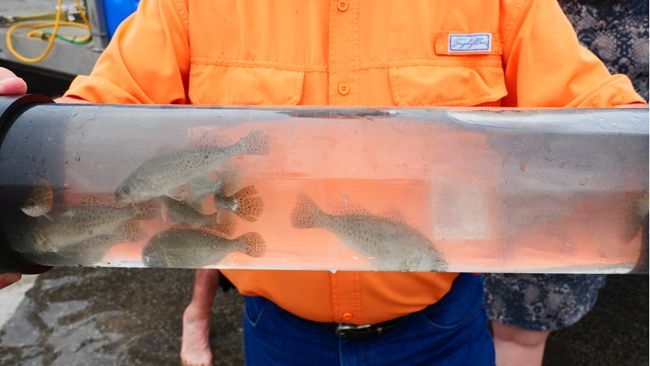27,000 seatrout released at Pine Island Beach in Spring Hill, FL
Hernando County, Florida - A collaboration between Hernando County, Florida, Duke Energy Mariculture Center, Coastal Conservation Association (CCA), and the Florida and Florida Fish and Wildlife Conservation Commission (FWC) has resulted in the release, in late June 2021, of approximately 20,000 hatchery-reared spotted seatrout at Alfred A. McKethan Pine Island Park, located at 10800 Pine Island Dr. in Spring Hill, Florida.
“Our ongoing efforts with the Duke Energy Mariculture Center are helping repopulate spotted seatrout in the Gulf ecosystem,” said CCA Florida Executive Director Brian Gorski. “Preserving and protecting marine environments for future generations is our mutual responsibility, and this restocking initiative will help revitalize one of Florida’s most popular inshore species.”
The juvenile spotted seatrout, raised for release at the Duke Energy Mariculture Center in Crystal River, Florida, are approximately 4 inches in length. The addition of these fish at Pine Island Park will allow the existing ecosystem to thrive and create more abundant recreational fishing opportunities. Spotted seatrout do not tend to travel far from where they are introduced, and many are likely to remain in the area. The Duke Energy Mariculture Center is a certified aquaculture facility and multispecies hatchery that grows and releases redfish and spotted seatrout into the Gulf of Mexico.
“Duke Energy is proud of our continued collaboration with the Coastal Conservation Association of Florida," said Melissa Seixas, Duke Energy Florida state president. "Together, we have successfully managed countless fish release projects throughout the state. We are committed to helping protect and responsibly manage Florida’s natural resources and are dedicated to helping support the vitality of our communities.”
Since opening in 1991, the Duke Energy Mariculture Center has cultivated and released more than 4.1 million fish and crustaceans (arthropods such as crabs, lobsters and shrimp). In addition, the center grows a variety of submerged aquatic vegetation, such as eelgrass, for lake and spring restoration and saltwater marsh vegetation, such as mangroves, for living shoreline projects to support the overall health of Florida’s fisheries and marine habitats. It is one of the most successful marine-stocking programs in Florida, focused on environmental stewardship and conservation.
“We are thrilled to partner with Duke Energy, CCA Florida and FWC to release these fish into our ecosystem here in Hernando County,” said Hernando County Administrator Jeff Rogers. “This is an excellent opportunity to not only enhance the existing marine environment but to also allow for better recreational fishing opportunities at this location for our residents and visitors.”
The Coastal Conservation Association (CCA) was founded in 1977 after drastic commercial overfishing along the Texas coast decimated redfish and speckled trout populations. One of 19 state chapters, CCA Florida, based in Orlando, became CCA's fifth state chapter in 1985. A 501(c)3 nonprofit, the purpose of CCA is to advise and educate the public on conservation of marine resources. Through habitat restoration projects, water quality initiatives and fisheries advocacy, CCA Florida works with its over 18,000 members including recreational anglers and outdoor enthusiasts to conserve and enhance marine resources and coastal environments.
Top
“Our ongoing efforts with the Duke Energy Mariculture Center are helping repopulate spotted seatrout in the Gulf ecosystem,” said CCA Florida Executive Director Brian Gorski. “Preserving and protecting marine environments for future generations is our mutual responsibility, and this restocking initiative will help revitalize one of Florida’s most popular inshore species.”
The juvenile spotted seatrout, raised for release at the Duke Energy Mariculture Center in Crystal River, Florida, are approximately 4 inches in length. The addition of these fish at Pine Island Park will allow the existing ecosystem to thrive and create more abundant recreational fishing opportunities. Spotted seatrout do not tend to travel far from where they are introduced, and many are likely to remain in the area. The Duke Energy Mariculture Center is a certified aquaculture facility and multispecies hatchery that grows and releases redfish and spotted seatrout into the Gulf of Mexico.
“Duke Energy is proud of our continued collaboration with the Coastal Conservation Association of Florida," said Melissa Seixas, Duke Energy Florida state president. "Together, we have successfully managed countless fish release projects throughout the state. We are committed to helping protect and responsibly manage Florida’s natural resources and are dedicated to helping support the vitality of our communities.”
Since opening in 1991, the Duke Energy Mariculture Center has cultivated and released more than 4.1 million fish and crustaceans (arthropods such as crabs, lobsters and shrimp). In addition, the center grows a variety of submerged aquatic vegetation, such as eelgrass, for lake and spring restoration and saltwater marsh vegetation, such as mangroves, for living shoreline projects to support the overall health of Florida’s fisheries and marine habitats. It is one of the most successful marine-stocking programs in Florida, focused on environmental stewardship and conservation.
“We are thrilled to partner with Duke Energy, CCA Florida and FWC to release these fish into our ecosystem here in Hernando County,” said Hernando County Administrator Jeff Rogers. “This is an excellent opportunity to not only enhance the existing marine environment but to also allow for better recreational fishing opportunities at this location for our residents and visitors.”
The Coastal Conservation Association (CCA) was founded in 1977 after drastic commercial overfishing along the Texas coast decimated redfish and speckled trout populations. One of 19 state chapters, CCA Florida, based in Orlando, became CCA's fifth state chapter in 1985. A 501(c)3 nonprofit, the purpose of CCA is to advise and educate the public on conservation of marine resources. Through habitat restoration projects, water quality initiatives and fisheries advocacy, CCA Florida works with its over 18,000 members including recreational anglers and outdoor enthusiasts to conserve and enhance marine resources and coastal environments.
